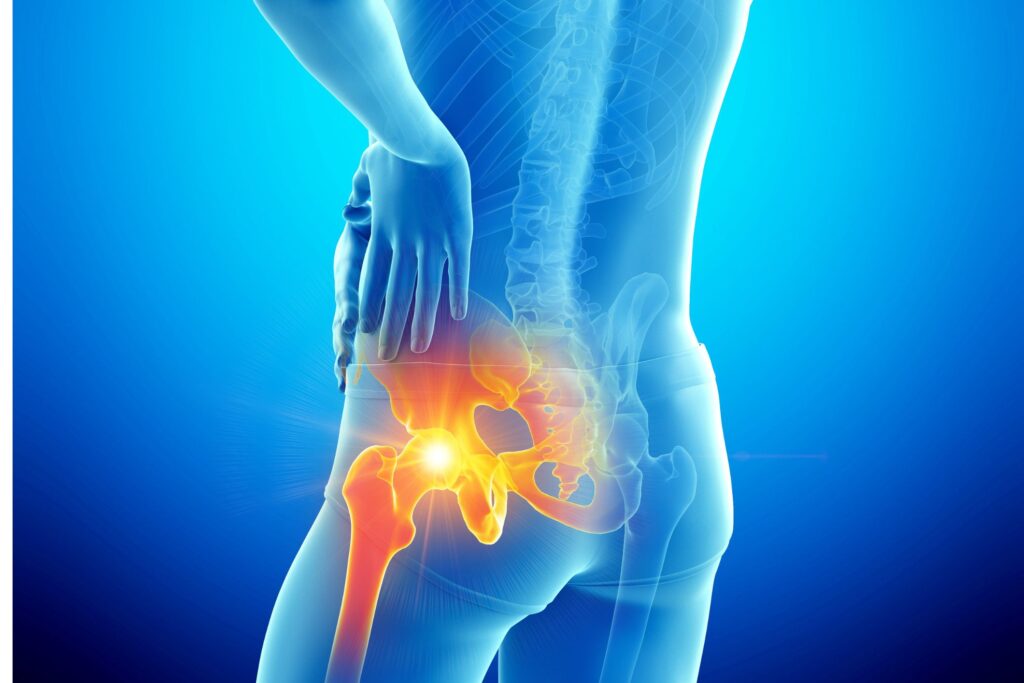Wondering why you feel pain in your hip and what you can do about it? Whether it’s an injury, arthritis, or another condition, pinpointing the common causes of hip pain and how to treat them can help you find relief.
This article will guide you through the most common causes of hip pain and the best ways to treat them.
Key Takeaways
Hip pain can result from various causes, including Osteoarthritis, Rheumatoid Arthritis, Bursitis, Tendonitis, Hip fractures, Labral tears, and Hip impingement. The treatment needed for hip pain depends on the underlying cause and severity of the pain, requiring a tailored approach to diagnosis and treatment.
Effective treatment options for hip pain range from conservative methods like rest, ice, and physical therapy to more advanced interventions such as minimally invasive surgery and hip replacement.
Preventative measures such as maintaining a healthy weight, engaging in regular low-impact exercise, seeing a clinician early if you experience pain and wearing proper footwear can significantly reduce the risk of developing hip pain.
Common Causes of Hip Pain
Hip pain can arise from a variety of sources, each with its unique set of symptoms and challenges. The hip bone, a crucial part of the hip joint’s anatomy, can be affected by wear and tear, leading to conditions such as osteoarthritis that impact the cartilage cushioning the hip bone. From accidents and injuries to chronic conditions like arthritis, the causes of hip pain are can be diverse and often interlinked.
Identifying these causes helps in finding the right treatment and restoring comfort and mobility.
Osteoarthritis
Osteoarthritis is a leading cause of hip pain. This condition is especially prevalent in older adults. This condition involves the gradual breakdown of cartilage in the hip joint, which cushions the hip bone, leading to worsening pain, stiffness, and a reduced range of motion.
Those suffering from hip osteoarthritis often experience a dull ache that can extend to the groin, thigh bone, knee, and buttocks, making everyday movements painful.
Managing your body weight is important because excess weight strains the hip joints, worsening pain and increasing the rate of further degeneration.
Rheumatoid Arthritis
Rheumatoid arthritis is another significant contributor to hip pain. Unlike osteoarthritis, which results from wear and tear, rheumatoid arthritis is an autoimmune condition that causes joint inflammation. This inflammation affects the hip joints, leading to significant pain and discomfort, and making movement difficult.
Hip Effusions/Synovitis can often be present in Rheumatoid Arthritis
Recognizing the link between rheumatoid arthritis and hip pain is key to effective management and treatment.
Bursitis
Bursitis is the inflammation of the bursa especially on the outer aspect of the hip, small fluid-filled sacs that provide cushioning to hip structures especially the gluteus tendons. This inflammation often causes discomfort during sleep, movement or physical activity, leading to a significant impact on one’s mobility and quality of life.
Activities involving repetitive motion or pressure on the hip bursa can worsen bursitis pain.
Tendonitis
Tendonitis around the hip results from repetitive motions or overuse, leading to pain and swelling in the affected area. This condition is particularly common among athletes and individuals engaged in activities that require repetitive hip movements. The tendon affected is often the hip flexor tendon (iliopsoas)
Tendonitis pain can be severe and may worsen with continued activity especially hip flexion, so addressing the issue early is important to prevent further damage.
Hip Fractures
Hip fractures are a serious cause of sudden hip pain, often resulting from falls or high-impact injuries that directly affect the hip bone. These fractures are more common among older adults due to weaker and more brittle bones, often exacerbated by conditions like osteoporosis.
Prompt treatment is necessary to manage severe pain and restore mobility, as hip fractures can significantly impair movement and daily activities.
Labral Tears
A labral tear involves a tear in the cartilage surrounding the hip joint, commonly affecting athletes and dancers due to their rigorous physical activities. Symptoms of a hip labral tear include pain in the hip or groin, limited range of motion, and a sensation of locking, catching, or clicking in the hip.
These symptoms can significantly hinder one’s ability to move comfortably and perform physical activities.
Hip Impingement
Hip impingement, also known as Femoral Acetabular Impingement (FAI), occurs when there is abnormal contact between the hip bone and the head of the thigh bone (femur), leading to pain and restricted movement. This condition often results from structural abnormalities in the hip joint, causing pain during activities that involve hip movement.
Recognizing the structural issues causing hip impingement is important for effective treatment and pain relief.
How to Treat Hip Pain
Treating hip pain involves a multifaceted approach, as the treatment needed for hip pain depends on the specific cause and severity of the pain. From conservative methods like rest and ice to more intensive treatments like injections and surgery, there are various ways to manage and reduce hip pain effectively.
These treatments can help in finding the most suitable approach for your condition and lifestyle.
Rest and Ice
Rest and ice are fundamental components of the RICE method — Rest, Ice, Compression, Elevation — commonly used to treat minor hip injuries.
Resting the hip joint helps prevent further damage and promotes healing, while applying ice packs can significantly reduce swelling and numb the pain.
This straightforward approach can ease hip pain from sports injuries and other minor conditions.
Physiotherapy
Physiotherapy is a cornerstone of hip pain treatment, focusing on enhancing hip muscle strength, flexibility, and reducing discomfort through targeted exercises. Personalized exercise regimens designed by physical therapists can significantly improve hip joint function and alleviate pain, making it a highly effective treatment for various hip conditions.
Medications
Over-the-counter painkillers like NSAIDs and paracetamol can significantly relieve hip pain. However, these medications should not be taken for more than a week without consulting a clinician.
Medications can be valuable, especially when combined with treatments like physical therapy.
Injections
There are several injections including Cortisone, Hyaluronic Acid, PRP and others for both pain relief and Joint regeneration
Minimally Invasive Surgery
For severe hip pain that does not respond to conservative treatments, minimally invasive surgery might be necessary.
Hip arthroscopy, a common minimally invasive surgery, involves small incisions and minimal tissue alteration, making it effective for conditions like labral tears and hip impingement.
This surgery can repair the labrum ‘trim’ down Cam deformities and correct hip alignment, offering significant pain relief and improved function.
Hip Replacement Surgery
In cases where hip pain and symptoms severely affect one’s ability to stand, walk, and perform daily activities, hip replacement surgery may be recommended.
This aggressive treatment option involves replacing the damaged hip joint with an artificial implant, significantly improving mobility and reducing pain.
Hip replacement surgery is considered when other treatments fail to relieve severe hip pain.
Preventing Hip Pain
Prevent hip pain by adopting proactive lifestyle changes that reduce the risk of injuries and chronic conditions affecting the hip joint. Maintaining a healthy weight, regular exercise, and proper footwear can significantly reduce the risk of hip pain.
Maintaining a Healthy Weight
Carrying excess body weight places significant stress on the hip joints, increasing the risk of pain and conditions like osteoarthritis.
Losing weight through a balanced diet and regular physical activity can alleviate this pressure, preventing hip pain and improving joint health.
Regular Exercise
Low-impact exercises like swimming, cycling, and walking help maintain and improve hip health without causing additional pain. These activities strengthen the muscles around the hips, enhance flexibility, and promote better joint function, playing a crucial role in hip pain prevention.
Proper Footwear
Proper footwear is vital for maintaining hip health and preventing pain. Shoes with good arch support and cushioning help ensure proper body alignment, reducing the likelihood of hip issues.
Flat shoes, in particular, promote better leg alignment and reduce hip strain, making them practical for everyday wear.
When to Seek Medical Advice
Knowing when to seek medical advice is important for effectively managing hip pain. Persistent or severe symptoms that do not improve with home treatments should prompt a consultation with a healthcare provider to ensure proper diagnosis and treatment.
Persistent Pain
If hip pain persists for more than a week despite home treatments, consulting a healthcare provider is necessary.
Symptoms that indicate serious hip issues requiring medical attention include:
Fever
Rash
Pain in both hips
Persistent pain after a week of rest
Corticosteroids may be used for quick relief from inflammation in such cases.
Severe Symptoms
Seek urgent medical attention if you experience severe hip pain after a fall, are unable to bear weight on the hip, or have significant bruising. These severe symptoms indicate serious injuries or conditions that require immediate medical intervention to prevent further complications.
Summary
Understanding the common causes of hip pain and the various treatment options is crucial for managing and preventing this common issue. From osteoarthritis and rheumatoid arthritis to bursitis and hip fractures, each cause requires a specific approach to treatment and management. By incorporating rest, physical therapy, medications, and, in severe cases, surgery, you can effectively manage hip pain and improve your quality of life.
Preventing hip pain involves proactive lifestyle changes such as maintaining a healthy weight, engaging in regular exercise, and wearing proper footwear. Recognizing when to seek medical advice is also essential for ensuring timely and effective treatment. By taking these steps, you can reduce the risk of hip pain and enjoy a more active, pain-free life.
Frequently Asked Questions
Should I keep walking with hip pain?
You should continue to walk with hip pain, as staying active can improve your overall health and prevent future issues. Just ensure you wear comfortable shoes and take precautions to minimize strain on your hip.
How do you make hip pain go away?
To alleviate hip pain, engage in low-impact activities like walking or swimming, and apply ice to the affected area for 20 minutes every few hours. Additionally, consider using over-the-counter pain relievers while avoiding direct pressure on your hip and limiting prolonged sitting or bending.
What are the most common causes of hip pain?
The most common causes of hip pain are Osteoarthritis, Rheumatoid arthritis, Bursitis, Tendonitis, Hip fractures, Labral tears, and Hip impingement. Understanding these conditions is vital for effective management and treatment.
How can I relieve hip pain at home?
To relieve hip pain at home, try resting, applying ice packs, and taking over-the-counter painkillers. Additionally, incorporate low-impact exercises and wear supportive footwear to alleviate discomfort.
When should I seek medical advice for hip pain?
You should seek medical advice for hip pain if it persists for more than a week despite home treatments, or if you experience severe symptoms such as inability to bear weight or significant bruising.

